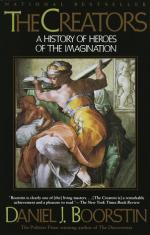
|
| Name: _________________________ | Period: ___________________ |
This test consists of 15 multiple choice questions and 5 short answer questions.
Multiple Choice Questions
1. What does the third-eye represent in Hindu art?
(a) Ancestors watching over people.
(b) The vision men share with the gods.
(c) Man's self-awareness.
(d) The ability of special men to see beyond physical sight.
2. For what was God cutting rods, in the quote from Martin Luther that opens Part 2?
(a) Wicked people.
(b) To use for writing.
(c) People who ask too many questions.
(d) People who don't inquire into the world.
3. When were the cave drawings discovered?
(a) 1700s.
(b) 1600s.
(c) 1900s.
(d) 1800s.
4. What part of Philo of Alexandria's philosophy does Boorstin say determined what man could know and what he could not?
(a) Logos.
(b) Techne.
(c) Nomos.
(d) Pneuma.
5. What does Boorstin say is the difference between tragedy and comedy?
(a) Tragedy dealt with kings, comedy with commoners.
(b) Tragedy dealt with long-ago events, comedy with the present.
(c) Tragedy was for intimate gatherings, comedy for large audiences.
(d) Tragedy ended in death, comedy in marriage.
6. What does Boorstin see in men making images of men?
(a) The beginning of language.
(b) Self-discovery.
(c) The beginning of religion.
(d) Consciousness.
7. What does Boorstin say Christianity got people to see?
(a) The nature of divinity.
(b) Time as cyclical.
(c) The future.
(d) Heaven.
8. What was Boccaccio's inspiration for the Decameron?
(a) Developments in the medieval church.
(b) The Wars of the Roses.
(c) The plague.
(d) The discovery of the New World.
9. What becomes harder to understand in a culture that believes in one god in Boorstin's account?
(a) The existence of evil.
(b) The nature of physical matter.
(c) The origins of the universe.
(d) Death.
10. In what does Boorstin say Rabelais' book was an act of faith?
(a) Culture.
(b) Literary history.
(c) Language.
(d) God.
11. To what use did Romans put sculpture according to Boorstin?
(a) Marking territories.
(b) Holding up buildings.
(c) Memorializing the dead.
(d) Teaching anatomy.
12. What does Boorstin say is Buddhism's response to the questions of living?
(a) To trust whatever the heart says.
(b) Not to answer.
(c) To refer all questions to sacred texts.
(d) To meditate but not to settle for any answer.
13. Why does Confucius say that it is impossible for men to serve the spirits?
(a) Because the ways of serving the spirits have all been forgotten.
(b) Because they cannot trust the sanctity of any texts.
(c) Because the spirits do not exist.
(d) Because they don't know how to serve each other.
14. What governs the relationship between mankind and Moses' God?
(a) The Old Testament.
(b) The fates.
(c) A covenant.
(d) Sacrifices.
15. What was the first literary work according to Boorstin?
(a) Thucydides' history.
(b) Petronius' Satyricon.
(c) Herodotus' history.
(d) Thales of Miletus' history.
Short Answer Questions
1. What did Greeks discover through drama according to Boorstin?
2. What does Boorstin say Moses introduced into Western culture?
3. What does Boorstin say is the paradoxical nature of Moses' God?
4. What does Boorstin say upturned stones signify?
5. What was the special element of Gothic architecture in Boorstin's opinion?
|
This section contains 545 words (approx. 2 pages at 300 words per page) |

|




